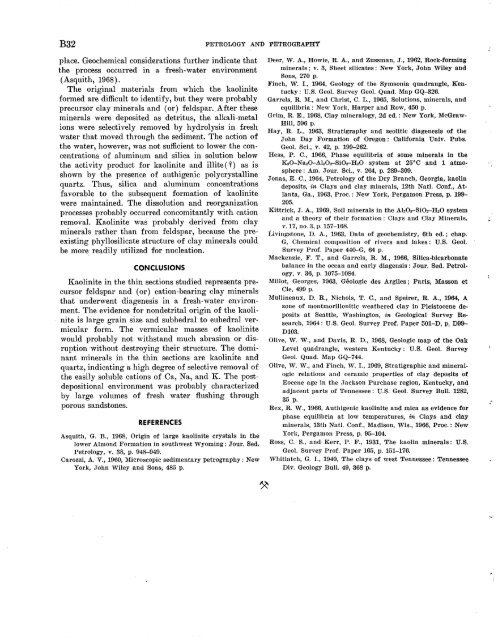RESEARCH· ·1970·
RESEARCH· ·1970·
RESEARCH· ·1970·
You also want an ePaper? Increase the reach of your titles
YUMPU automatically turns print PDFs into web optimized ePapers that Google loves.
B32<br />
PETROLOGY AND PETROGRAPHY<br />
place. Geochemical considerations further indicate that<br />
the process occurred in a fresh-water environment<br />
(Asquith, 1968)-.<br />
The original materials from which the kaolinite<br />
formed are difficult to identify, but they were probably<br />
precursor clay minerals and (or) feldspar. After these<br />
minerals were deposited as detritus, the alkali-metal<br />
ions were selectively removed by hydrolysis in f.resh<br />
\Yater that moved through the sediment. The action of<br />
the water, however, was .not sufficient to lower the concentrations<br />
of aluminum and silica in solution below<br />
the activity product for kaolinite and illite ( ~) as is<br />
shown by the presence of authigenic polycrystalline<br />
quartz. Thus, silica and aluminum concentrations<br />
·favorable to the subsequent formation of kaolinite<br />
were maintained. The dissolution and reorganization<br />
process~s probably occurred concomitantly with cation<br />
removal. l{aolinite was probably derived from clay<br />
minerals rather than from feldspar, ·because the preexisting<br />
phyllosilicate structure of clay minerals could<br />
be more readily utilized for nucleation.<br />
CONCLUSIONS<br />
1\.:aolinite in the thin sections studied represents precursor<br />
feldspar and (or) cation-bearing clay minerals<br />
that underwent diagenesis in a fresh-w.ater environment.<br />
The evidence for nondetrital origin of the kaolinite<br />
is large grain size and subhedral to euhedral vermicular<br />
form. The vermicular masses of kaolinite<br />
would probably not withstand much abrasion or disruption<br />
·without destroying their structure. The dominant<br />
minerals in the thin sections· are kaolinite and<br />
quartz, indicating a high degree of selective removal of<br />
the easily soluble cations of Ca, N a, and IC The postdepositional<br />
environment was probably characterized<br />
by large volumes of fresh water flushing through<br />
porous sandstones.<br />
R,E.FERENCES<br />
Asquith, G. B., 1968, Origin of large kaolinite crystals in the<br />
lower Almond Formation in southwest 'Vyoming: .Jour. Sed;<br />
Petrology, v. 38, p. 948-949.<br />
Carozzi, A. V., 1960, Microscopic sedimentary petrography: New<br />
Yorl{, John Wiley and Sons, 485 p.<br />
Deer, W. A., Howie, R. A., and Zussman, J., 1962, Rock-forming<br />
minerals; v. 3, Sheet silicates: New York, John Wiley and<br />
Sons, 270 p.<br />
Finch, W. 1., 1964, Geology of the Symsonia quadrangle, Kentucky:<br />
U.S. Geol. Survey Geol. Quad. Map GQ-326.<br />
Garrels, R. M., and Christ, C. L., 1965, Solutions, minerals, and<br />
equilibria: New York, Harper and Row, 450 p.<br />
Grim, R. E., 1968,.Cla-y mineralogy, 2d ed.: New York, McGraw<br />
Hill, 596 p.<br />
Hay, R. L., 1963, Stratigraphy and zeolitic diagenesis of the<br />
John Day Formation of Oregon: California Univ. Pubs.<br />
Geol. Sci., v. 42, p. 199-262.<br />
Hess, P. C., 1966, Phase equilibria of some minerals in the<br />
K20-Na20-AbO:r-SiO:r-H20 system at 25°C and 1 atmosphere:<br />
Am .. Tour. Sci., v. 264, p. 289-309.<br />
Jonas, E. C., 1964, Petrology of the Dry Branch, Georgia, kaolin<br />
deposits, in Clays and clay minerals, 12th Natl. Conf., Atllmta,<br />
GiL, 1963, Proc. : New York, Pergamon Press, p. 199-<br />
205.<br />
Kittrick, J. A., 1969, Soil minerals in the AbO:r-SiO:rH20 system<br />
and .a theory of their formation: Clays and Clay Minerals,<br />
v.17, no. 3, p. 157-168.<br />
Livingstone, D. A., 1963, Data of geochemistry, 6th ed.; chap.<br />
G, Chemical composition of rivers and lakes: U.S. Geol.<br />
Survey Prof. Paper 440-G, 64 p.<br />
Mackenzie, F. T., and Garrels, R. M., 1966, Silica-bicarbonate<br />
balance in the ocean and early diagensis: Jour. Sed. Petrology,<br />
v. 36, p. 1075-1084.<br />
Millot, Georges, 1963, Geologie des Argiles ; Paris, Masson et<br />
Cie, 499 p.<br />
Mullineaux, D. R., Nichols, T. C., and Speirer, R. A., 1964, A<br />
zone of montmorillonitic weathered clay in Pleistocene deposits<br />
at Seattle, 'Vashington, in Geological Survey Research,<br />
1964: U.S. Geol. Survey Prof. Paper 501-D, P: D99-<br />
D103.<br />
Olive, \V. W., and Davis, R. D., 1968, Geologic map of the Oak<br />
Level quadrangle, western Kentucky: U.S. Geol. Survey<br />
Geol. Quad. Map GQ-744.<br />
Olive, \V. W., and Finch, "r· 1., 1969, Stratigraphic and mineralogic<br />
relations and ceramic properties of clay deposits of<br />
Eocene age in the Jackson Purchase region, Kentucky, and<br />
adjacent parts of Tennessee: U.S. Geol. Survey Bull. 1282,<br />
35 p.<br />
Rex, R. \V., 1966, Authigenic kaolinite and mica as evidence for<br />
phase equilibria at low temperatures, in Clays and Clay<br />
minerals, 13th Natl. Conf., Madison, Wis., 1966; Proc.: New<br />
York, Pergamon Press, p. 95-104.<br />
Ross, C. S., and· Kerr, P. F., 1931, The kaolin minerals: U.S.<br />
Geol. Survey Prof. Paper 165, p. 151-176.<br />
\Vhitlatch, G. I., 1940, The clays of west Tennessee: Tennessee<br />
Div. Geology Bull. 49, 368 p.
















